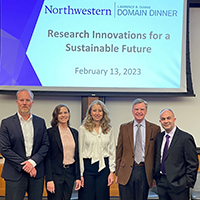“Research Innovations for a Sustainable Future” Spotlights Collaboration as Key to Addressing Climate
 As consequences of ongoing industrialization, the climate and sustainability crises we face will not be solved without similar leaps in green technology. At the February 13th panel “Research Innovations for a Sustainable Future”, a group of sustainability leaders in chemistry, engineering, and economics highlighted the breadth of projects on campus addressing the challenges of a sustainable future as part of the Lawrence B. Dumas Domain Dinner series. Addressing their colleagues from across the university, speakers Jennifer Dunn, Meghan Busse, and Ted Sargent, panelist Michael Wasielewski, and moderator Omar Farha also emphasized the need to innovate with a larger impact in mind. As Busse noted, “no matter how wonderful a technology is, if it never leaves the lab, it isn’t adopted at scale, it won't affect the planet.” Only in centering the effects of that adoption on supply chains, resource scarcity, markets, and communities can researchers begin to build a truly sustainable world.
As consequences of ongoing industrialization, the climate and sustainability crises we face will not be solved without similar leaps in green technology. At the February 13th panel “Research Innovations for a Sustainable Future”, a group of sustainability leaders in chemistry, engineering, and economics highlighted the breadth of projects on campus addressing the challenges of a sustainable future as part of the Lawrence B. Dumas Domain Dinner series. Addressing their colleagues from across the university, speakers Jennifer Dunn, Meghan Busse, and Ted Sargent, panelist Michael Wasielewski, and moderator Omar Farha also emphasized the need to innovate with a larger impact in mind. As Busse noted, “no matter how wonderful a technology is, if it never leaves the lab, it isn’t adopted at scale, it won't affect the planet.” Only in centering the effects of that adoption on supply chains, resource scarcity, markets, and communities can researchers begin to build a truly sustainable world.
Electric vehicles offer a useful example. A major research focus of Dunn’s is Life Cycle Assessment, a process for quantifying and comparing the environmental impact of an item from resource extraction through disposal. While EVs offer clear greenhouse gas emission benefits when compared to fossil-fuel powered vehicles, critical minerals needed for their batteries require additional trade-offs. As Dunn noted, “most of our lithium-ion battery supply chain lies today outside of our borders. We're relying on countries that don't have the same labor and environmental protections that we do here.” The Inflation Reduction Act, which calls for dramatic increases in battery production by 2027 while imposing point of origin requirements on critical mineral components, brings these problems to a head. “How many tax credit eligible batteries can we make in that stretch of time based on what we know today, from our supply chain and the market value of these minerals? The answer was, well, not enough to meet demand. We can do about half as well as we might want to do.” These assessments also elide the human and environmental costs of mining, with Dunn highlighting her work with anthropologist Sera Young identifying delocalization, child labor, water insecurity, biodiversity loss, and deforestation as consequences of cobalt mining that might not show up on an emissions comparison chart. In making the choices needed to increase production further, Life Cycle Assessments that capture the true scope of a technology’s impact will be necessary to weigh competing solutions.
Economist Meghan Busse demonstrated the need for such difficult choices. In order to reduce warming projections from catastrophic to viable levels, net zero emissions will be required by the middle of the century. Doing so will require technological advances in energy storage, electrified, transportation, and especially in high-heat industrial processes, but real gains also rely on interventions in energy infrastructure, transportation networks, and the kinds of government-driven incentives that make the adoption of those measures economically attractive enough for private actors to adopt en masse. Building partnerships between research institutions, governments, and businesses offers a path forward, with development subsidies supporting the flow of new technologies that will need to be designed with practical, scalable implementation in mind above all other factors.
In practice, though, what will need to happen to reach net zero emissions? Ted Sargent set the pace, forecasting a need to quadruple solar and wind capacity increases, decrease costs, and increase resource use efficiency, all of which will require scaling and implementation of new technologies at a rate ten times faster than we currently are. All of these advances will require immense creativity and teamwork, and Sargent accompanied his forecasts with some of the major innovations happening around campus. Mercouri Kanatzidis’ perovskites allow us to tune solar cells to the sun’s full spectrum, with breaking advances in stabilization molecules from the Sargent group moving the concept further forward. Omar Farha, Randall Snurr, and Chris Wolverton have utilized AI sorting to rapidly identify viable catalyst candidates at speeds up to 60 times faster than human researchers, with Chad Mirkin making similar advances in nanomaterials. Speaking to his fellow researchers, Sargent called for an emphasis on building teams with “interdigitating expertise”, combining disciplinary diversity with a strong mission focus.
It was a theme that all three speakers returned to in the Q&A, as exchanges with representatives from all over the university highlighting the impacts that interdisciplinary research can have in addressing problems individual researchers would not ordinarily consider. CESR hopes to foster these collaborations through its Seed Grants program, and welcomes opportunities for sustainability partnerships within and beyond the university.
